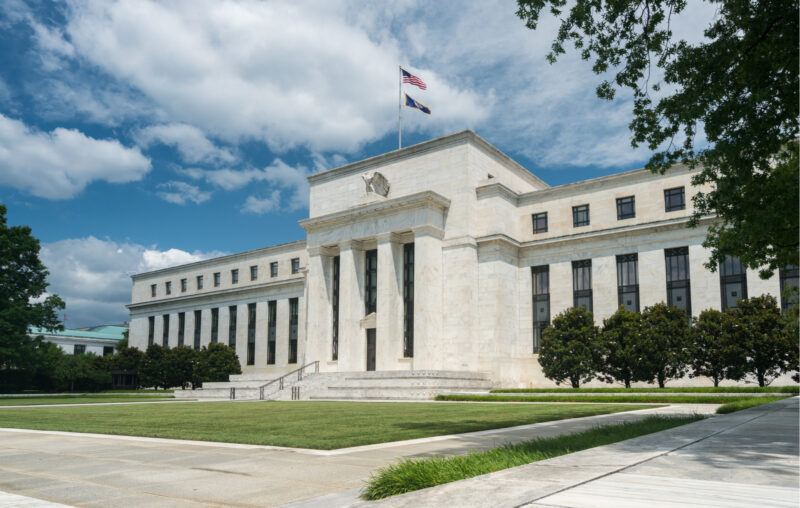The Thin Green Line

Last week on 60 Minutes, Fed Chairman Jerome Powell gave his most detailed interview on the Fed’s response to the COVID crisis. He specifically addressed what has become arguably the most unique aspect of the Fed’s COVID response: its targeted aid to nonbank businesses.
“In the last crisis, the problems were in the financial system,” Powell noted. “Here, really, the problems are in the real economy,” meaning that they are primarily affecting businesses that produce real goods and services. “We’re trying to do what we can to get [these businesses] through this period.”
In March, the Fed invoked the emergency powers granted in Section 13(3) of the Federal Reserve Act to introduce two new lending facilities: the Primary Market Corporate Credit Facility (PMCCF) and the Secondary Market Corporate Credit Facility (SMCCF). The programs were created to inject up to $750 billion in direct credit to large corporations. It also revived its Commercial Paper Funding Facility (CPFF), a Great Recession-era program designed to support the commercial paper market and help corporations finance their day-to-day operations.
In April, the Fed again invoked Section 13(3) to introduce two of its most novel responses to the crisis. The Main Street Lending Program allowed the Fed to inject up to $600 billion in credit to medium-sized businesses that are too large to qualify for the Small Business Administration’s Paycheck Protection Program (PPP) and too small to access the Fed’s two corporate credit facilities. The Municipal Liquidity Facility allowed the Fed to purchase up to $500 billion in eligible state and municipal bonds.
Although the Fed’s new lending facilities have not attracted much criticism from economists (though there are some exceptions), proponents of a rule-based monetary system should view them skeptically. In brief, the Fed should focus on monetary policy. It should not attempt to allocate credit to various sectors and firms.
The Fed does not have the knowledge that would be required to allocate credit efficiently. It has enough trouble getting the aggregate level of money and credit right for the entire economy. Adding to that already overwhelmingly complex job the task of siphoning credit to private nonbank businesses is a sure-fire formula for failure.
The first (and last) time the Fed toyed with Main Street lending programs was during the New Deal. The results were disappointing, to put it mildly. Today’s efforts will likely prove just as ineffective. And, given their enormous magnitude, they could prove much more costly.
Even if the Fed could adequately allocate credit to nonbank businesses, it should not do so. It’s just not the Fed’s job. If credit allocation programs are called for, they rightly reside in the hands of the fiscal authority. The case for establishing a strict separation of monetary and fiscal responsibility is enshrined in the U.S. Constitution. Congress alone is granted the authority to allocate public funds—and for good reason. We don’t want to give unelected bureaucrats carte blanche to gamble with taxpayer money. And we want politicians to bear the costs of financing controversial spending programs at the voting booth.
Worse still is the possibility that politicians begin to see monetary policy as a Trojan horse for advancing their own policy agendas. On March 16, for instance, Maxine Waters (D-CA), Chair of the House Committee on Financial Services, called for the Fed to require that firms raise their minimum wage to $15 an hour in order to receive loans. She also called for the Fed to engage in a “money-financed fiscal program” that would provide direct monthly cash payments to individuals and households for the duration of the crisis.
To be clear, one need not oppose raising the minimum wage or providing cash payments to individuals to reject such proposals being financed by the Fed. One need only recognize the danger in enabling politicians to bypass the legislative process and impose their partisan agendas through the central bank. Waters’ proposal is undemocratic and wholly inconsistent with Fed independence. But, so long as the Fed is given such wide-ranging authority to allocate credit, we can expect to see more of these calls.
Far from delivering the “normalization” that the Fed had promised ever since its unprecedented interventions in the Great Recession, everything that the Fed has done (and, sadly, Congress has encouraged it all) in response to the COVID crisis has pushed it further in the direction of allocating credit. And, as I’ve argued before, this will have dire ramifications for the Fed’s ability to respond adeptly to future economic crises.
It will almost certainly lower future economic growth. Central banks lack both the knowledge and incentives to successfully allocate credit to its most productive uses. That is a job for private banks, and one that they have performed exceptionally well throughout history when not burdened by excessive regulation and government interventions. The more savings allocated by the central bank, the less allocated by more effective private banks and, correspondingly, the more credited is misallocated. That’s bad for economic growth.
Corporations and medium-sized businesses should not be left out to dry, particularly when governments have mandated that they shut down or significantly curtail their operations. There is an important distinction between a business going under due to its own failures and one failing simply because of a government-forced shutdown. It would be a shame if otherwise viable firms were forced to shutter their doors. As Powell himself argued in the 60 Minutes interview, the businesses that the Fed has targeted with its new credit facilities are generally “perfectly good companies” that had “sound financial conditions as recently as February” but thanks to the shutdown “now have no business.”
That said, the Fed isn’t well-positioned to decide which small and medium businesses are “perfectly good” credit risks and which aren’t. Its focus should rightly be on getting the aggregate amount of liquidity right while exposing taxpayers to as little credit risk as possible.
There is a reasonable case for expanding the set of assets the Fed might purchase, especially in times of crisis. But the rules that govern these decisions should be predictable. George Selgin has outlined a proposal. And, if the Fed were to adopt these principles, it would not have to create an alphabet soup of ad hoc credit facilities to meet the specific needs of each unique crisis. It would, instead, put the monetary system on a solid foundation that works both in good times and bad, thereby reducing uncertainty and increasing market confidence.
Political leaders have rightly been criticized for failing to prepare for an epidemic in the early stages of the COVID outbreak. Our monetary leaders have similarly failed. They failed to make long overdue changes to our monetary framework. The result is a much clumsier response and a much worse recession than was necessary.










